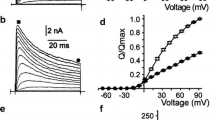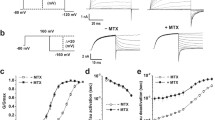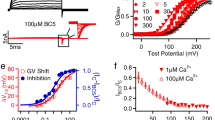Abstract
Effects of Cd2+, Co2+, Fe2+ and Mg2+ (1 μM and 100 μM) and Pb2+ (1 μM and 90 μM) on single-channel properties of the small-conductance (SK) and large-conductance (BK) Ca2+-activated K+ channels were investigated in inside-out patches of N1E-115 mouse neuroblastoma cells. Cd2+, Co2+ and Pb2+, but not Fe2+ and Mg2+, cause SK channel opening. The potency of the metals in enhancing the SK channel-open probability follows the sequence Cd2+ ≈ Pb2+>Ca2+>Co2+≫ Mg2+, Fe2+. The four metals that cause SK channel opening are equipotent in enhancing the opening frequency of SK channels. The BK channel is activated by Pb2+ and Co2+, whereas Cd2+, Fe2+ and Mg2+ are ineffective. The potency of the metals in enhancing BK channel-open probability, open time and opening frequency follows the sequence Pb2+>Ca2+>Co2+≫Cd2+, Mg2+, Fe2+. The results show that SK channels are much more sensitive to Cd2+ than BK channels and indicate that Cd2+ is a selective agonist of SK channels. It is concluded that the various metal ions bind to the same regulatory site(s) at which Ca2+ activates the SK and BK channels under physiological conditions. The different potency sequences of metal ions with respect to BK and SK channel activation indicate that the regulatory sites of these Ca2+-activated K+ channeles have distinct chemical and physical properties.
Similar content being viewed by others
References
Bernardi H, Bidard JN, Fosset M, Hugues M, Mourre C, Rehm H, Romey G, Schmid-Antomarchi H, Schweitz H, de Weille JR, Lazdunski M (1989) Molecular properties of potassium channels. Drug Res 39:159–163
Chao SH, Suzuki Y, Zysk JR, Cheung WY (1984) Activation of calmodulin by various metal cations as a function of ionic radius. Mol Pharmacol 26:75–82
Golowasch J, Kirkwood A, Miller C (1986) Allosteric effects of Mg2+ on the gating of Ca2+-activated K+ channels from mammalian skeletal muscle. J Exp Biol 124:5–13
Gorman ALF, Hermann A (1979) Internal effects of divalent cations on potassium permeability in molluscan neurones. J Physiol (Lond) 296:393–410
Grygorczyk R, Schwarz W (1983) Properties of the Ca2+-activated K+ conductance of human red cells as revealed by the patch-clamp technique. Cell Calcium 4:499–510
Grygorczyk R, Schwarz W (1985) Ca2+-activated K2+ permeability in human erythrocytes: Modulation of single-channel events. Eur Biophys J 12:57–65
Habermann E, Crowell K, Janicki P (1983) Lead and other metals can substitute for Ca2+ in calmodulin. Arch Toxicol 54:61–70
Hagiwara S, Byerly L (1981) Calcium channels. Annu Rev Neurosci 4:69–125
van Heeswijk MPE, Geertsen JAM, van Os CH (1984) Kinetic properties of the ATP-dependent Ca2+ pump and the Na+/Ca2+ exchange system in basolateral membranes from rat kidney cortex. J Membr Biol 79:19–31
Horn R, Lange K (1983) Estimating kinetic constants from single channel data. Biophys J 43:207–223
Hugues M, Romey G, Duval D, Vincent JP, Lazdunski M (1982) Apamin as a selective blocker of the calcium-dependent potassium channel in neuroblastoma cells: voltage-clamp and biochemical characterization of the toxin receptor. Proc Natl Acad Sci USA 79:1308–1312
Jacobsen KB, Turner JE (1980) The interaction of cadmium and certain other metal ions with proteins and nucleic acids. Toxicology 16:1–37
Lancaster B, Nicoll RA, Perkel DJ (1991) Calcium activates two types of potassium channels in rat hippocampal neurones in culture. J Neurosci 11:23–30
Lansman JB, Hess P, Tsien RW (1986) Blockade of current through single calcium channels by Cd2+, Mg2+, and Ca2+. J Gen Physiol 88:321–347
Leinders T, Vijverberg HPM (1992) Ca2+ dependence of small Ca2+-activated K+ channels in cultured N1E-115 mouse neuroblastoma cells. Pflügers Arch 422:223–232
Markovac J, Goldstein GW (1988) Picomolar concentrations of lead stimulate brain protein kinase C. Nature 334:71–73
Müller TH, Swandulla D, Lux HD (1989) Activation of three types of membrane currents by various divalent cations in identified molluscan pacemaker neurons. J Gen Physiol 94:997–1014
Narahashi T, Tsunoo A, Yoshii M (1987) Characterization of two types of calcium channels in mouse neuroblastoma cells. J Physiol (Lond) 383:231–249
Oberhauser A, Alvarez O, Latorre R (1988) Activation by divalent cations of a Ca2+-activated K+ channel from skeletal muscle membrane. J Gen Physiol 92:67–86
Oortgiesen M, van Kleef RGDM, Bajnath RB, Vijverberg HPM (1989) Nanomolar concentrations of lead selectively block neuronal nicotinic responses in mouse neuroblastoma cells. Toxicol Appl Pharmacol 103:165–174
Oortgiesen M, van Kleef RGDM, Vijverberg HPM (1990) Novel type of ion channel activated by Pb2+, Cd2+, and Al3+ in cultured mouse neuroblastoma cells. J Membr Biol 113:261–268
Oortgiesen M, Leinders T, van Kleef RGDM, Vijverberg HPM (1992) Differential neurotoxic effects of lead on voltage-dependent and receptor-operated ion channels. Neurotoxicology (in press)
Perrin DG (1979) Stability constants of metal-ion complexes, part B. Organic ligands. IUPAC Chemical Data Series no. 22. Pergamon, Oxford
Quandt F (1988) Three kinetically distinct potassium channels in mouse neuroblastoma cells. J Physiol (Lond) 395:401–418
Richardt G, Federolf G, Habermann E (1986) Affinity of heavy metal ions to intracellular Ca2+-binding proteins. Biochem Pharmacol 35:1331–1336
Shields M, Grygorczyk K, Fuhrmann GF, Schwarz W, Passow H (1985) Lead-induced activation and inhibition of potassium-selective channels in the human red blood cell. Biochim Biophys Acta 815:223–232
Sillen LG, Martell AE (1971) Stability constants of metal-ion complexes. Special publication no. 25 [Suppl 1]. The Chemical Society, London
Simons TJB (1985) Influence of lead ions on cation permeability in human red cell ghosts. J Membr Biol 84:61–71
Spencer PS, Schaumburg HH (1980) Experimental and clinical neurotoxicology. Williams & Wilkins, Baltimore
Winegar BD, Kelly R, Lansman JB (1991) Block of current through single calcium channels by Fe, Co, and Ni. J Gen Physiol 97:351–367
Yellen G (1984) Ionic permeation and blockade in Ca2+-activated K+ channels of bovine chromaffine cells. J Gen Physiol 84: 157–186
Author information
Authors and Affiliations
Rights and permissions
About this article
Cite this article
Leinders, T., van Kleef, R.G.D.M. & Vijverberg, H.P.M. Divalent cations activate small- (SK) and large-conductance (BK) channels in mouse neuroblastoma cells: selective activation of SK channels by cadmium. Pflügers Arch 422, 217–222 (1992). https://doi.org/10.1007/BF00376205
Received:
Revised:
Accepted:
Issue Date:
DOI: https://doi.org/10.1007/BF00376205




